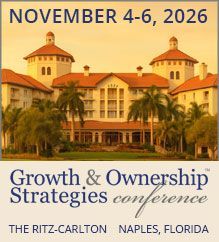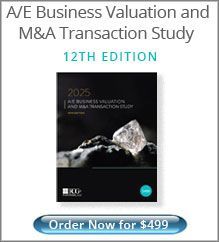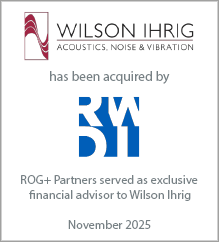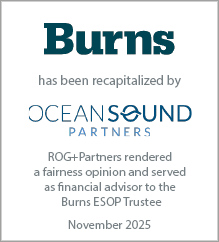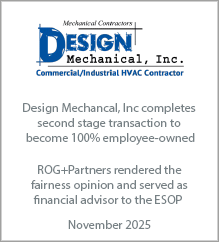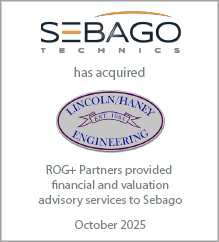Ian has spent the past twenty years working with hundreds of architecture, engineering and environmental consulting firms large and small throughout the U.S. and abroad with a focus on ownership planning, business valuation, ESOP advisory services, mergers & acquisitions, and strategic planning. Ian is a professionally trained and accredited business appraiser and holds the Accredited Senior Appraiser (ASA) designation with the American Society of Appraisers and is a certified merger & acquisition advisor (CM&AA) with the Alliance of Merger & Acquisition Advisors.
A Tale of Two ESOP Companies
September 10, 2025
Employee stock ownership plans, or ESOPs, continue to be a popular ownership strategy for firms in the architecture, engineering and environmental consulting industry. In fact, A/E firms are over-represented among the largest ESOP-owned companies in the U.S. Over 20% of the firms on the National Center for Employee Ownership’s (nceo.org) latest published list of the country’s largest ESOP companies were A/E firms.
A/E firms are natural candidates for ESOP ownership for a number of reasons. For one, professional services firms are usually employee-owned in some fashion, so culturally and operationally, broadening ownership to ALL employees through an ESOP does not represent a fundamental change. ESOPs are also more feasible in professional services firms from a compliance perspective, due to the fact that payroll is an A/E firm’s largest operational expense. Tax deductible employer contributions to defined contribution plans, such as ESOPs, are limited to 25% of the employee’s compensation. So A/E firms are rarely constrained by this limitation.
There are a number of ways ESOPs may be used as part of a firm’s ownership transition strategy. While ESOPs are designed to invest primarily in the sponsoring company’s stock, they may hold ownership stakes ranging from small minority interests up to a 100% interest. And ESOPs may be leveraged—borrowing from sellers, third-party lenders, or both in order to purchase shares, or pre-funded with cash contributions from the company.
In the broader world of ESOPs across all industries, the 100% ESOP owned structure has become the most common model, due to the tax advantages this structure brings. When combined with a subchapter S election for income tax treatment, the 100% ESOP firm effectively pays no federal income taxes on corporate profits. However, this structure is less common in the A/E sector.
Of the firms participating in the 2025 A/E Business Valuation and M&A Transactions Study, 26.1% sponsored ESOPs, and the average ESOP ownership was 50.2%, with interests ranging from 9.7% to 100%. And in our own ESOP consulting practice, the average ESOP ownership among our client firms was 46.8%, with the most common range being 30-40%.
Below are two case studies illustrating the formation of two distinct examples of ESOP-owned A/E firms, and the pros and cons of each. While based on actual companies, the company and individual names are fictitious.
Case Study 1: The 100% Leveraged ESOP
Enterprise Engineering is a 150-person civil engineering and environmental consulting firm. At the time of its ESOP formation, its founder, John Smith, still owned 70% of the outstanding shares, with the remainder distributed among ten other principals. Mr. Smith was nearing retirement and in need of liquidity but preferred to transition the company ownership to employees as opposed to selling to a larger firm or private equity investor.
The firm hired an ESOP advisor who assessed the feasibility of an ESOP transaction, including estimating the company’s value range, coming up with the framework of a transaction and helping to arrange financing. An independent trustee was appointed, who in turn engaged a financial advisor and attorney on behalf of the ESOP.
The negotiated transaction involved the company borrowing sufficient funds from a third-party lender (a regional bank), and in turn lending that money to the ESOP to buy all the shares from the minority interest shareholders, and a portion of the shares held by the founder—Mr. Smith. The remainder of the shares purchased from Mr. Smith were financed with a subordinated seller note.
The net result was that the ESOP became the sole owner of the company and the seller was able to make a tax election (a 1042 rollover) to defer the capital gains tax on the sale. The Company subsequently converted to a subchapter S corporation, thereby saving on corporate income taxes and enhancing its cash flow.
However, as a result of the transaction, the company became highly leveraged (i.e., with high levels of debt relative to equity and earnings), causing it to be more at-risk in the event of an economic downturn. Contrast this to case study 2.
Case Study 2: The Pre-funded ESOP
ABC Environmental is a 75-person environmental consulting practice. The company was founded by three individuals and has since grown to become broadly owned by a group of 20 employee-shareholders. With the three founders nearing retirement and still collectively holding 45% of the outstanding shares, management decided to explore an ESOP as a strategy for redeeming the founders’ shares in a tax-effective way, and without burdening the firm or the other shareholders with excessive debt.
As the firm had always operated conservatively, with little debt, management decided that a leveraged ESOP would not be preferable. Its ESOP advisor conducted a feasibility study and developed a pre-funded model. In this model, the ESOP would be created, but rather than borrowing money, the company would contribute funds to the plan each year out of operating profits.
Three years later, after the ESOP had accumulated sufficient funds, it used the cash in the plan to purchase one-third of the shares held by the founders, making it a 15% shareholder. Over the next several years, the ESOP made additional purchases until the founders were fully bought out and the plan was a 45% owner.
This type of approach requires advance planning and takes longer to accomplish the goals of the retiring shareholders. But it avoids saddling the company with a high amount of debt, and it also allows for a majority of the ownership (55% in this case) to be held disproportionately by the key leaders and managers of the firm.
Conclusion:
Most people’s opinions of ESOPs are colored by their personal experience with a particular type of plan. But ESOPs come in all shapes and sizes. The examples above simply represent opposite ends of a wide spectrum. Furthermore, firms that begin with a minority-interest ESOP structure, may decide later to become a majority or even 100% ESOP-owned company. And vice-versa, a majority ESOP-owned company may decide to slowly reduce the ESOP’s ownership to a minority owner (or even buy out and terminate the plan altogether).
In many ways, it’s this flexibility that makes ESOPs so popular, and a potential ownership transition tool for such a wide variety of firms.


